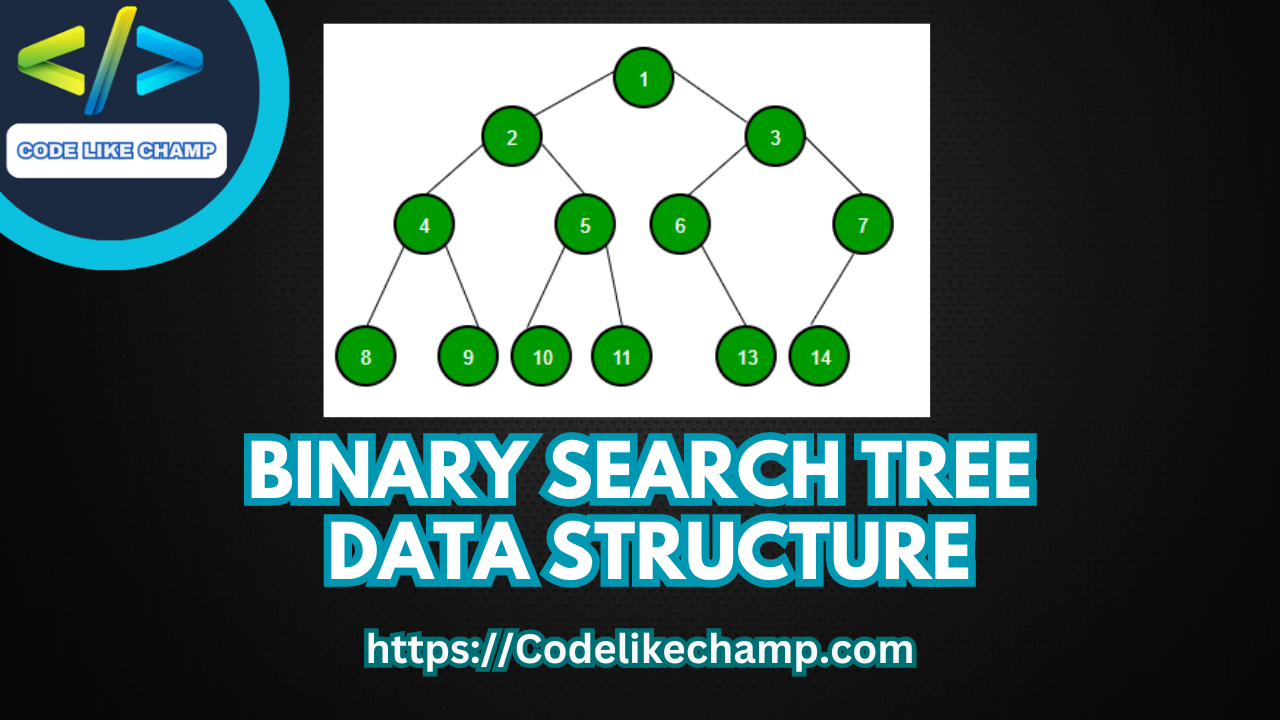Introduction to Binary Search Tree
In the realm of data structures, Binary Search Tree (BSTs) stand out as a fundamental tool, offering efficient storage and retrieval capabilities while maintaining order. In this comprehensive article, we delve into the intricacies of Binary Search Trees, exploring their definition, applications, characteristics, types, advantages, disadvantages, and the key differences between binary trees and Binary Search Trees.

What is Binary Search Trees
A Binary Search Tree (BST) is a hierarchical data structure composed of nodes, where each node has at most two children, referred to as the left child and the right child. The key feature of a BST is that the data in each node is ordered in such a way that for any node, all nodes in its left subtree have values less than the node’s value, and all nodes in its right subtree have values greater than the node’s value. This ordering property enables efficient searching, insertion, and deletion operations.
Why We Use Binary Search Trees in Data Structure
Binary Search Trees are extensively used in data structures due to their ability to maintain order and facilitate efficient searching operations. By organizing data in a hierarchical and ordered manner, BSTs provide quick access to elements, making them ideal for applications like dictionary implementations, database indexing, and symbol tables.
Characteristics of Binary Search Trees
- Ordered Structure: Nodes in a Binary Search Tree are arranged in a specific order based on their values, allowing for efficient searching using binary search.
- Balanced Height: Ideally, a BST maintains balanced height, ensuring that the height of the left and right subtrees of any node differs by at most one. This balanced property optimizes performance for various operations.
- Unique Keys: Binary Search Trees typically store unique keys, ensuring that no two nodes in the tree have the same value.
- Dynamic Operations: BSTs support dynamic operations like insertion, deletion, and searching, enabling the structure to adapt to changing data requirements efficiently.
Types of Binary Search Trees
- Balanced Binary Search Trees: A BST in which the height of the tree is kept balanced to ensure optimal performance for search, insertion, and deletion operations. Examples include AVL trees, Red-Black trees, and Splay trees.
- Unbalanced Binary Search Tree: A BST where the height of the tree may become skewed, leading to inefficient operations in the worst-case scenario.
Advantages of Binary Search Trees
- Efficient Searching: Binary Search Trees provide efficient searching capabilities, with average-case time complexity of O(log n) for search operations, where n is the number of nodes in the tree.
- Ordered Access: BSTs maintain the order of elements, allowing for range-based queries and traversal operations in sorted order.
- Dynamic Operations: BSTs support dynamic operations like insertion and deletion while maintaining the ordering property, making them versatile for various applications.
- Space Efficiency: Binary Search Trees optimize space utilization by only storing necessary data, resulting in efficient memory usage.
Disadvantages of Binary Search Trees
- Unbalanced Trees: Without proper balancing mechanisms, Binary Search Trees may become unbalanced, leading to degraded performance for certain operations and increasing the height of the tree.
- Complexity: Implementing and managing balanced Binary Search Trees can be complex, requiring careful consideration of balancing algorithms and additional overhead for maintaining balance.
Difference Between Binary Tree and Binary Search Tree
While both Binary Trees and Binary Search Trees are hierarchical data structures composed of nodes, the key difference lies in their organization and properties:
- Binary Trees: A Binary Tree is a general tree structure where each node can have at most two children, without any specific ordering property. It may or may not be ordered, making it suitable for various applications.
- Binary Search Trees: A Binary Search Tree is a specific type of Binary Tree where the data in each node is ordered in such a way that the left subtree contains values less than the node’s value, and the right subtree contains values greater than the node’s value. This ordering property enables efficient searching using binary search algorithms.
Code Examples in Various Languages
Below are code examples demonstrating the implementation of a Binary Search Tree in different programming languages:
Binary Search Trees in C#
using System;
public class Node
{
public int data;
public Node left, right;
public Node(int item)
{
data = item;
left = right = null;
}
}
public class BinarySearchTree
{
public Node root;
public BinarySearchTree()
{
root = null;
}
public void Insert(int key)
{
root = InsertRec(root, key);
}
private Node InsertRec(Node root, int key)
{
if (root == null)
{
root = new Node(key);
return root;
}
if (key < root.data)
root.left = InsertRec(root.left, key);
else if (key > root.data)
root.right = InsertRec(root.right, key);
return root;
}
public void Inorder()
{
InorderRec(root);
}
private void InorderRec(Node root)
{
if (root != null)
{
InorderRec(root.left);
Console.Write(root.data + " ");
InorderRec(root.right);
}
}
}
class Program
{
static void Main(string[] args)
{
BinarySearchTree tree = new BinarySearchTree();
// Insert sample elements
tree.Insert(50);
tree.Insert(30);
tree.Insert(20);
tree.Insert(40);
tree.Insert(70);
tree.Insert(60);
tree.Insert(80);
// Print inorder traversal
Console.WriteLine("Inorder traversal:");
tree.Inorder();
}
}
Output
Inorder traversal: 20 30 40 50 60 70 80
These code examples demonstrate the insertion of elements into a Binary Search Tree and printing their inorder traversal, resulting in an ordered sequence of elements.
Binary Search Trees in C
#include <stdio.h>
#include <stdlib.h>
struct Node
{
int data;
struct Node *left, *right;
};
struct Node *createNode(int key)
{
struct Node *newNode = (struct Node *)malloc(sizeof(struct Node));
newNode->data = key;
newNode->left = newNode->right = NULL;
return newNode;
}
struct Node *insert(struct Node *root, int key)
{
if (root == NULL)
return createNode(key);
if (key < root->data)
root->left = insert(root->left, key);
else if (key > root->data)
root->right = insert(root->right, key);
return root;
}
void inorder(struct Node *root)
{
if (root != NULL)
{
inorder(root->left);
printf("%d ", root->data);
inorder(root->right);
}
}
int main()
{
struct Node *root = NULL;
// Insert sample elements
root = insert(root, 50);
insert(root, 30);
insert(root, 20);
insert(root, 40);
insert(root, 70);
insert(root, 60);
insert(root, 80);
// Print inorder traversal
printf("Inorder traversal:\n");
inorder(root);
return 0;
}
Output
Inorder traversal: 20 30 40 50 60 70 80
These code examples demonstrate the insertion of elements into a Binary Search Tree and printing their inorder traversal, resulting in an ordered sequence of elements.
Binary Search Trees in C++
#include <iostream>
using namespace std;
class Node
{
public:
int data;
Node *left, *right;
Node(int item)
{
data = item;
left = right = NULL;
}
};
Node *insert(Node *root, int key)
{
if (root == NULL)
return new Node(key);
if (key < root->data)
root->left = insert(root->left, key);
else if (key > root->data)
root->right = insert(root->right, key);
return root;
}
void inorder(Node *root)
{
if (root != NULL)
{
inorder(root->left);
cout << root->data << " ";
inorder(root->right);
}
}
int main()
{
Node *root = NULL;
// Insert sample elements
root = insert(root, 50);
insert(root, 30);
insert(root, 20);
insert(root, 40);
insert(root, 70);
insert(root, 60);
insert(root, 80);
// Print inorder traversal
cout << "Inorder traversal:" << endl;
inorder(root);
return 0;
}
Output
Inorder traversal: 20 30 40 50 60 70 80
These code examples demonstrate the insertion of elements into a Binary Search Tree and printing their inorder traversal, resulting in an ordered sequence of elements.
Binary Search Trees in Python
class Node:
def __init__(self, key):
self.left = None
self.right = None
self.val = key
def insert(root, key):
if root is None:
return Node(key)
if key < root.val:
root.left = insert(root.left, key)
elif key > root.val:
root.right = insert(root.right, key)
return root
def inorder(root):
if root:
inorder(root.left)
print(root.val, end=" ")
inorder(root.right)
root = None
# Insert sample elements
root = insert(root, 50)
insert(root, 30)
insert(root, 20)
insert(root, 40)
insert(root, 70)
insert(root, 60)
insert(root, 80)
# Print inorder traversal
print("Inorder traversal:")
inorder(root)
Output
Inorder traversal: 20 30 40 50 60 70 80
These code examples demonstrate the insertion of elements into a Binary Search Tree and printing their inorder traversal, resulting in an ordered sequence of elements.
Binary Search Trees in PHP
<?php
class Node
{
public $data;
public $left;
public $right;
public function __construct($item)
{
$this->data = $item;
$this->left = null;
$this->right = null;
}
}
function insert($root, $key)
{
if ($root == null)
return new Node($key);
if ($key < $root->data)
$root->left = insert($root->left, $key);
elseif ($key > $root->data)
$root->right = insert($root->right, $key);
return $root;
}
function inorder($root)
{
if ($root != null)
{
inorder($root->left);
echo $root->data . " ";
inorder($root->right);
}
}
$root = null;
// Insert sample elements
$root = insert($root, 50);
insert($root, 30);
insert($root, 20);
insert($root, 40);
insert($root, 70);
insert($root, 60);
insert($root, 80);
// Print inorder traversal
echo "Inorder traversal:\n";
inorder($root);
?>
Output
Inorder traversal: 20 30 40 50 60 70 80
These code examples demonstrate the insertion of elements into a Binary Search Trees and printing their inorder traversal, resulting in an ordered sequence of elements.
Binary Search Trees in JAVA
class Node {
int data;
Node left, right;
public Node(int item) {
data = item;
left = right = null;
}
}
class BinarySearchTree {
Node root;
Node insert(Node root, int key) {
if (root == null) {
root = new Node(key);
return root;
}
if (key < root.data)
root.left = insert(root.left, key);
else if (key > root.data)
root.right = insert(root.right, key);
return root;
}
void inorder(Node root) {
if (root != null) {
inorder(root.left);
System.out.print(root.data + " ");
inorder(root.right);
}
}
public static void main(String[] args) {
BinarySearchTree tree = new BinarySearchTree();
// Insert sample elements
tree.root = tree.insert(tree.root, 50);
tree.insert(tree.root, 30);
tree.insert(tree.root, 20);
tree.insert(tree.root, 40);
tree.insert(tree.root, 70);
tree.insert(tree.root, 60);
tree.insert(tree.root, 80);
// Print inorder traversal
System.out.println("Inorder traversal:");
tree.inorder(tree.root);
}
}
Output
Inorder traversal: 20 30 40 50 60 70 80
These code examples demonstrate the insertion of elements into a Binary Search Trees and printing their inorder traversal, resulting in an ordered sequence of elements.
Binary Search Tree in JavaScript
class Node {
constructor(data) {
this.data = data;
this.left = null;
this.right = null;
}
}
function insert(root, key) {
if (root === null)
return new Node(key);
if (key < root.data)
root.left = insert(root.left, key);
else if (key > root.data)
root.right = insert(root.right, key);
return root;
}
function inorder(root) {
if (root !== null) {
inorder(root.left);
process.stdout.write(root.data + " ");
inorder(root.right);
}
}
let root = null;
// Insert sample elements
root = insert(root, 50);
root = insert(root, 30);
root = insert(root, 20);
root = insert(root, 40);
root = insert(root, 70);
root = insert(root, 60);
root = insert(root, 80);
// Print inorder traversal
console.log("Inorder traversal:");
inorder(root);
Output
Inorder traversal: 20 30 40 50 60 70 80
These code examples demonstrate the insertion of elements into a Binary Search Trees and printing their inorder traversal, resulting in an ordered sequence of elements.
Conclusion
In conclusion, Binary Trees serve as indispensable tools in the realm of data structures, offering a balanced blend of efficiency, flexibility, and space optimization. Understanding their characteristics, types, advantages, and disadvantages is crucial for leveraging their potential effectively in various applications. By harnessing the power of Binary Trees, developers can navigate through complex data structures with ease, unlocking new possibilities in software development and problem-solving.
For more visit my website Codelikechamp.com
If you face any issue regarding this topic or any other topic please ask or contact me without any hesitation.
For more visit my website Codelikechamp.com




